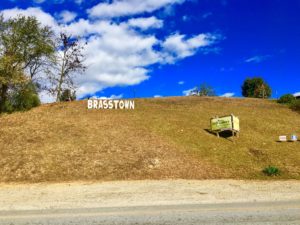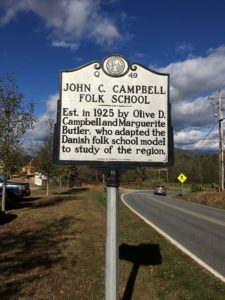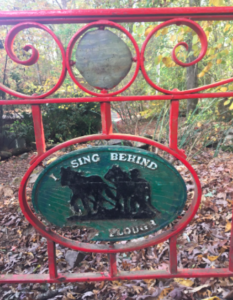By Samantha Lubliner, 2016
 Past a gas station screenshot from the ‘60s was the town of Brasstown. Composed of a mail center, library, and gas station, the surrounding hill was a collection of homes bordered with signs encouraging the election of Trump/Pence.
Past a gas station screenshot from the ‘60s was the town of Brasstown. Composed of a mail center, library, and gas station, the surrounding hill was a collection of homes bordered with signs encouraging the election of Trump/Pence.
The John C. Campbell Folk school lays just beyond the town with an old fashioned white sign marking its emergence beyond the trees. We parked in a full parking lot and walked toward what looked like a visitor center.
Branded with Danish vowels and values, the trip to the Folk School was grabbing onto the threads of Danish education systems. We started in the history center and were able to speak with Matthew Brose, a folklorist who specialized in Anthropology.
 Embedded between conversations of life and relationships, he spoke about the history of the Folk School in milestones. Between the dedicated commitment to working the land and building a new system of education was a history of community. His work focuses on documenting the stories of the people who populate the folk school. He mentioned that his interviews from the past few years have been especially interesting since he is recording and telling the story of the grandchildren he originally spoke to in the formation of the folk school in the 1920s. The motto of the folk school, as seen by the countless signs and embossing is “I sing behind the plough.”
Embedded between conversations of life and relationships, he spoke about the history of the Folk School in milestones. Between the dedicated commitment to working the land and building a new system of education was a history of community. His work focuses on documenting the stories of the people who populate the folk school. He mentioned that his interviews from the past few years have been especially interesting since he is recording and telling the story of the grandchildren he originally spoke to in the formation of the folk school in the 1920s. The motto of the folk school, as seen by the countless signs and embossing is “I sing behind the plough.”
We asked the vendor in the craft store about the meaning. As he pulled out an old piece of paper, a poem written in the ____, he offered to make a copy for us. The line of the poem reads “I sing when the impulse comes to fly light and free. I sing behind the plough and to the sound of mowing.” The man told us that the motto serves as a constant reminder to find joy in the land and within daily tasks.
 The crafts of the folk school were varying in discipline and medium. Kaleidoscopes, mosaics, and pottery sprinkled the wooden show room with color. Their craft store was composed of aisles of colorful art crafted throughout North Carolina. Each stand of work had the name of the artist and the home of the craft on a small paper in front of the pieces.
The crafts of the folk school were varying in discipline and medium. Kaleidoscopes, mosaics, and pottery sprinkled the wooden show room with color. Their craft store was composed of aisles of colorful art crafted throughout North Carolina. Each stand of work had the name of the artist and the home of the craft on a small paper in front of the pieces.
Scenic barnhouses and gardens escalated the beauty of the grounds from a North Carolina town into a community.
